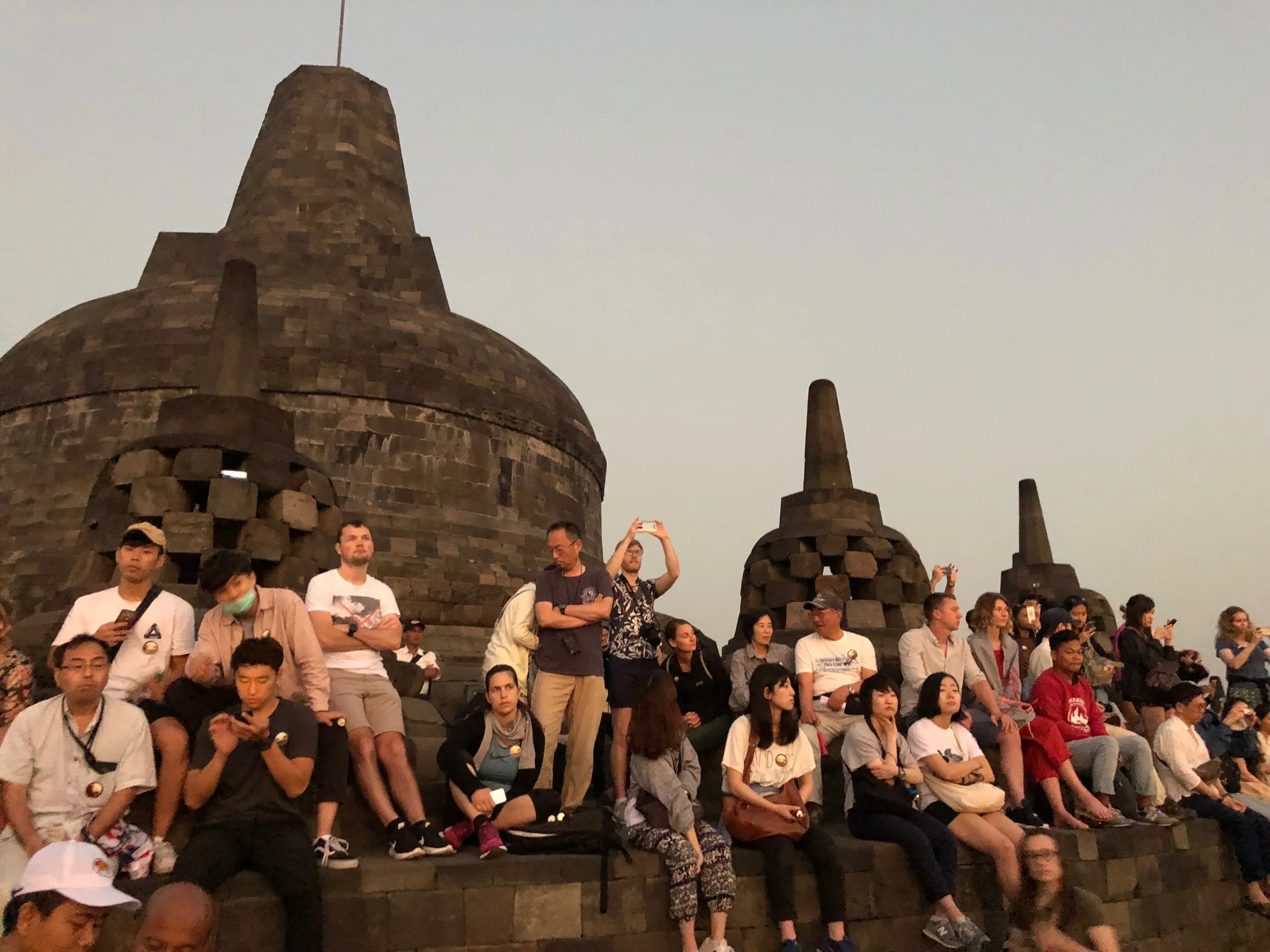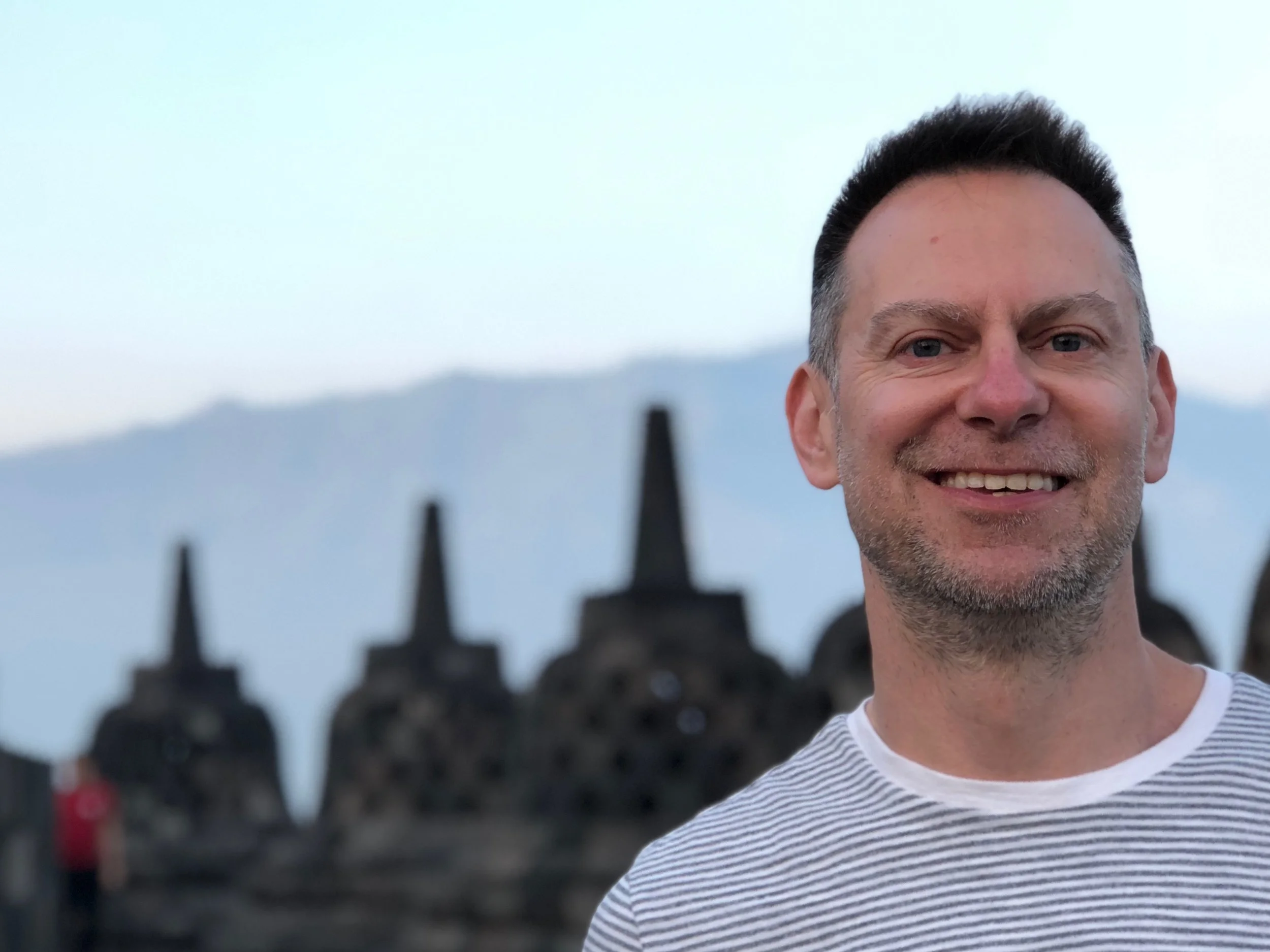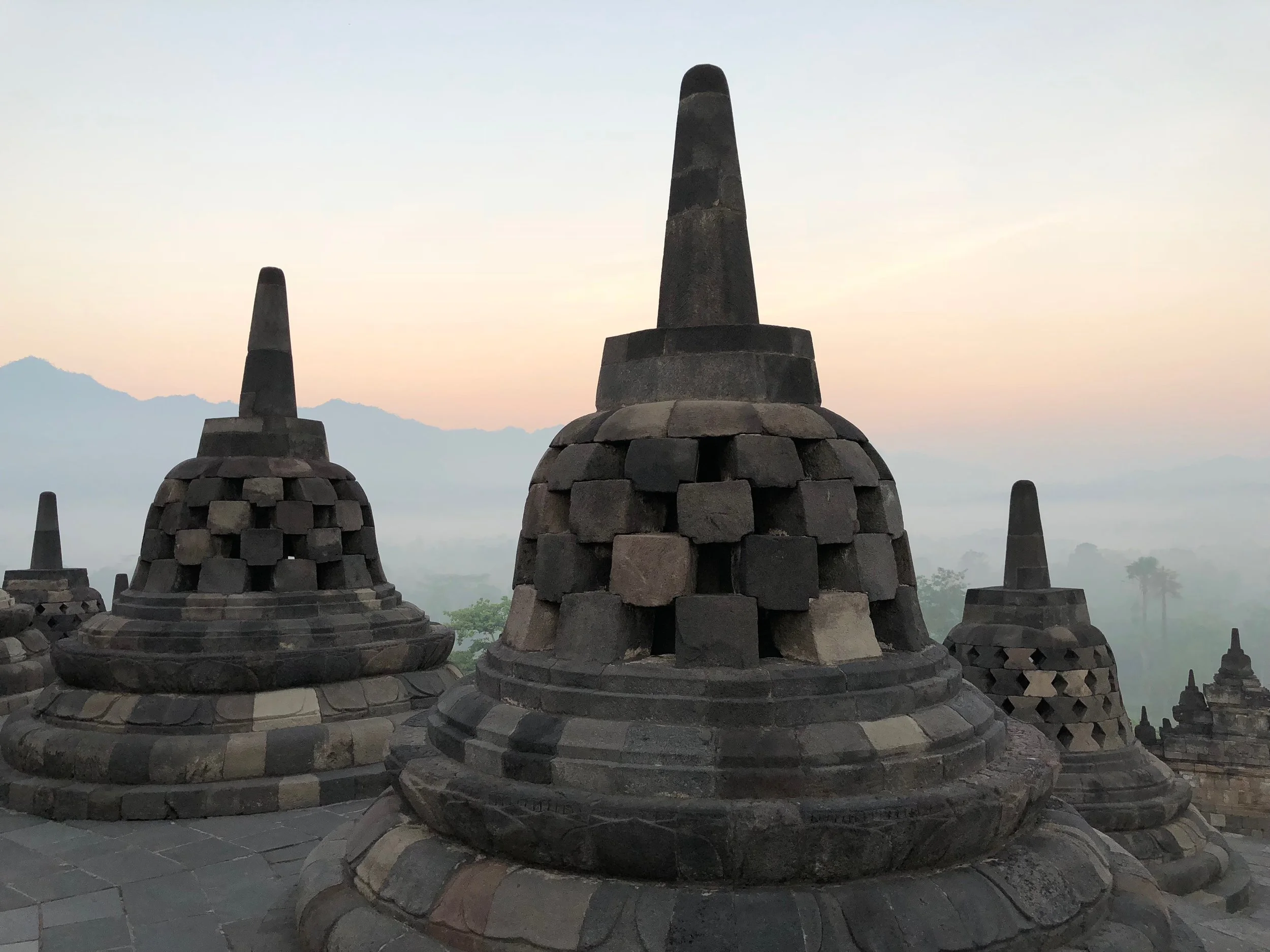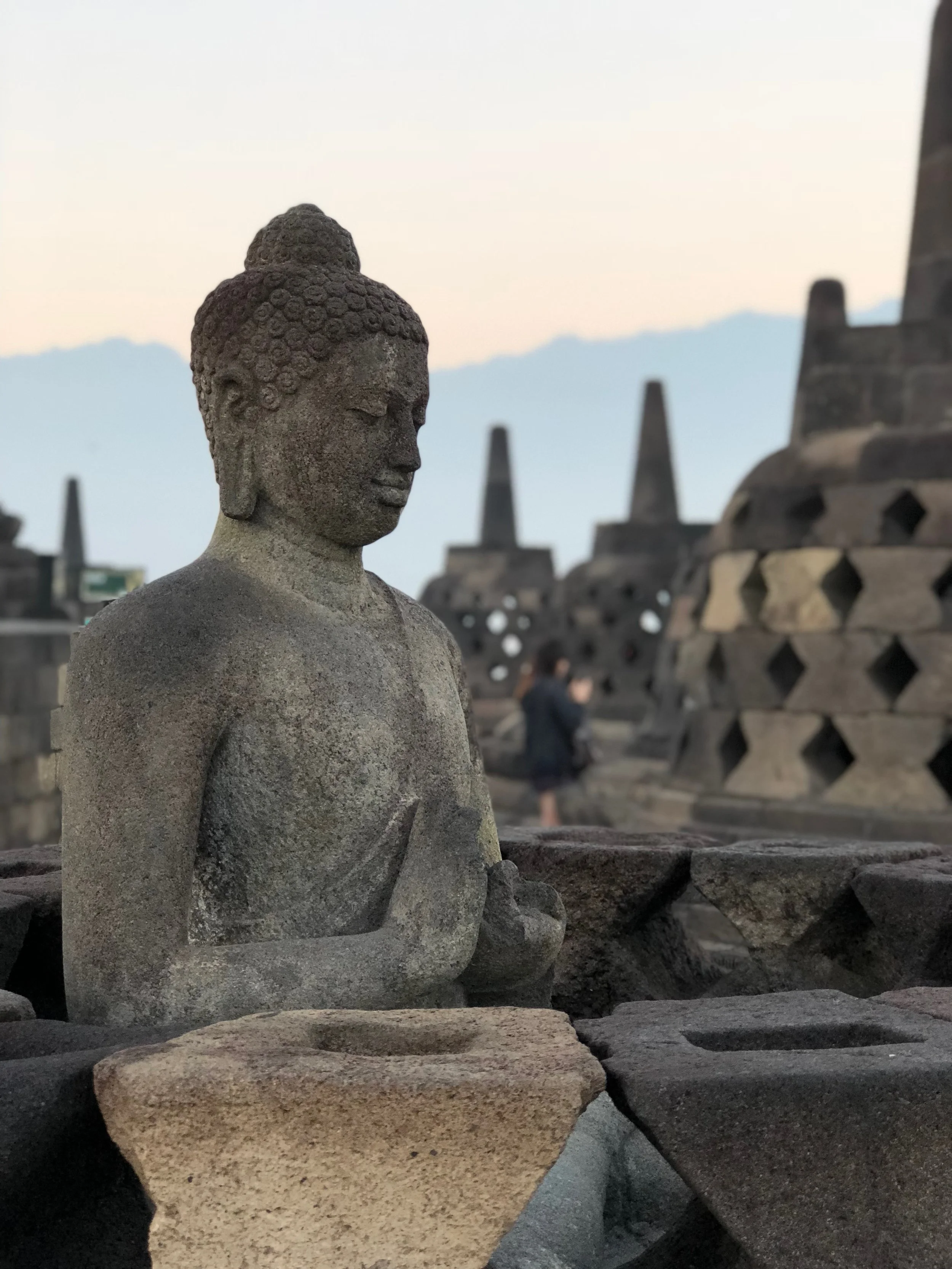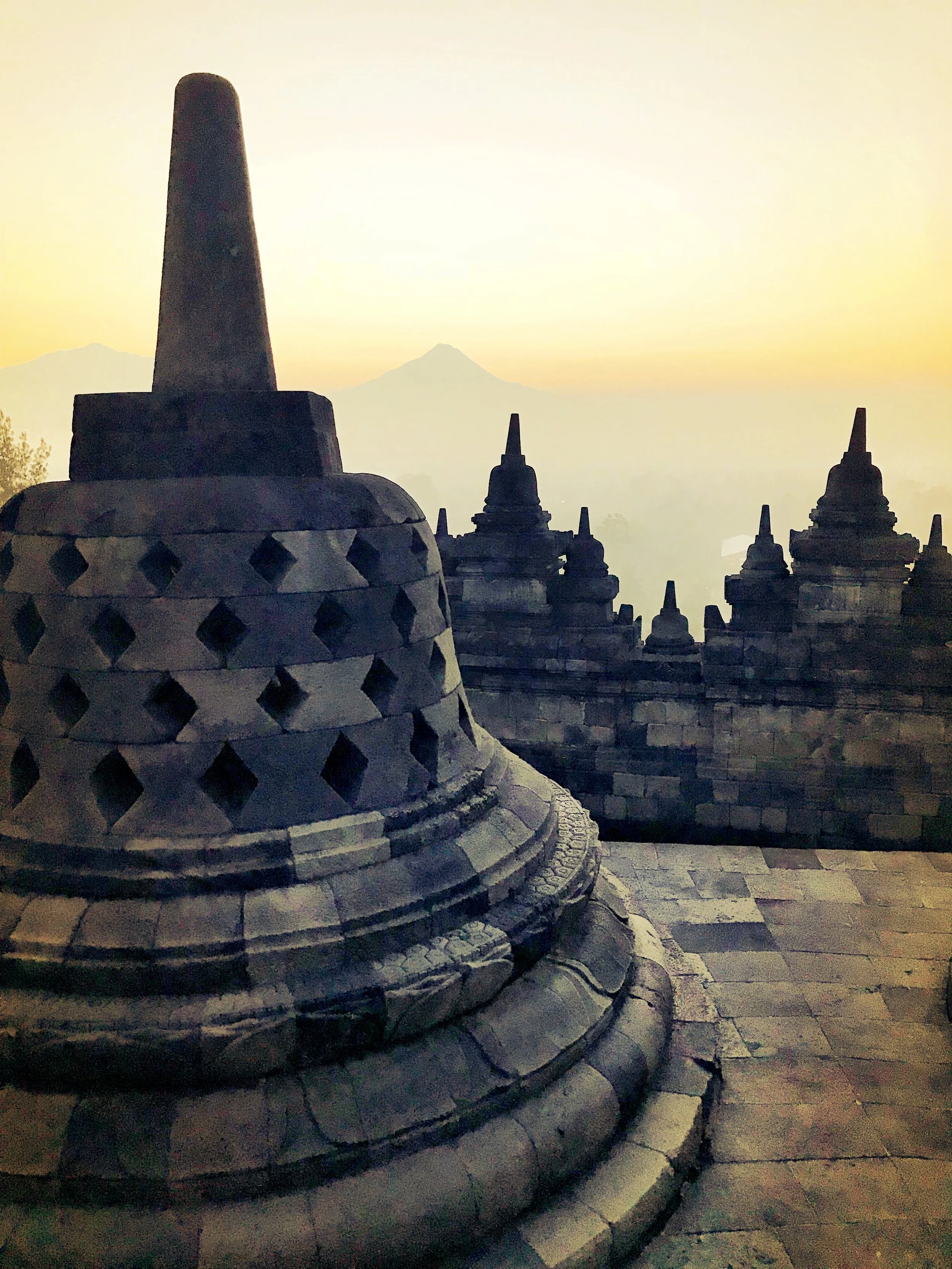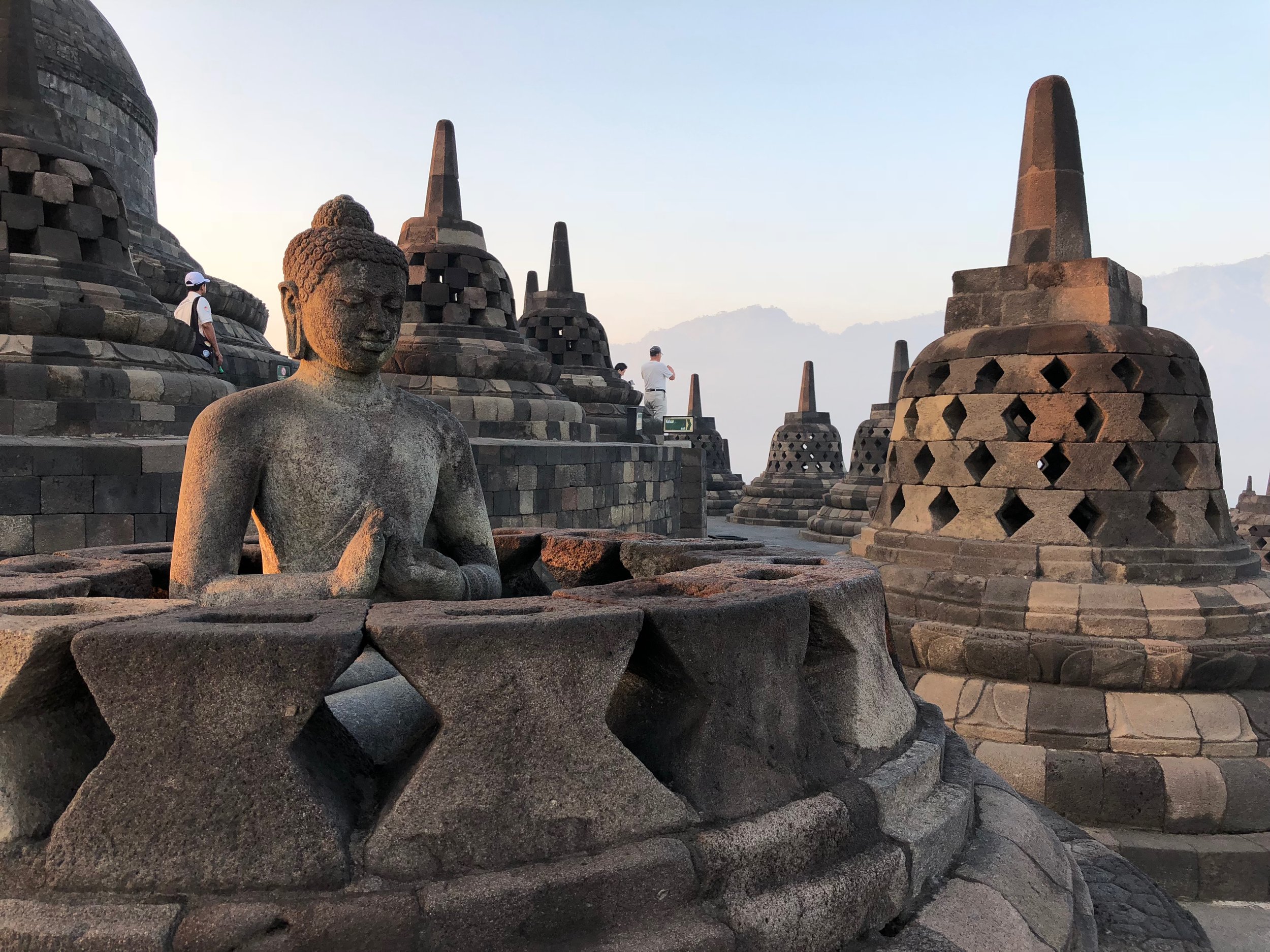The largest Buddhist monument in the world, with its iconic bell-shaped stupas, is a must-visit on Java, Indonesia.
Book a sunrise tour at Borobudur to see the silhouettes of the stupas materialize from the morning mist
When Wally mentioned that we should visit Bali, I suggested we spend a few days on the nearby island of Java, exploring the largest Buddhist monument in the world, Borobudur. I had seen images of the magical 9th century monument rising from the jungle mist, with its countless perforated bell-shaped stone stupas and seated Buddha statues.
You have to carefully position yourself — and get there early — to frame your photos without any of the throngs of tourists
I purchased our tickets for the sunrise visit through the Plataran Borobudur Resort, where we were staying, for 870,000 rupiah each (about $60). On our second day, the concierge rang our villa at 4 a.m. As a precautionary measure, I also set my iPhone alarm — Wally and I never travel without earplugs, and I didn’t want to risk us sleeping through the call. We quickly got dressed and had coffee in the lobby before meeting our driver and heading out in the darkness to Borobudur.
“I wasn’t expecting us to be alone, but I also wasn’t expecting to share this experience with hundreds of others.”
Volcanos can be seen in the distance — in fact, violent eruptions in the past covered the entire temple in ash for 800 years
Our driver’s name was Wishnu. Without missing a beat, Wally asked if he was named after the Hindu deity Vishnu. He chuckled and said, “No, it’s just a very common name.” To which Wally replied, “So you don’t ride Garuda?” Wishnu took a moment to think about this, saying, “No, I ride Yamaha,” referring to his scooter.
We passed some parked buses, where local students awaited transport to Borobudur. When I asked Wishnu about them, he explained that the temple is a popular school trip but doesn’t open to the public until 6 a.m.
Stay after the sunrise to wander the various levels of Borobudur
Shortly thereafter we arrived at the Manohara Hotel, which is located on the grounds of the historic site, and where sunrise tours depart from every morning. There clearly were a lot of people waiting to gain 4:30 a.m. access. I wasn’t expecting us to be alone, but I also wasn’t expecting to share this experience with hundreds of others so early in the morning.
As we queued up to enter, we were given a small flashlight and introduced to our guide, Pras. He told us that the site draws in an average of 300 visitors for sunrise and up to 56,000 per day during the high season.
This is the real Borobudur you don’t ever see in pictures — the hundreds of tourists all vying for a prime spot to photograph sunrise
Wally and I followed Pras up a central staircase, the beams from our flashlights bobbing as we made our way up to the circular seventh terrace. We squeezed ourselves behind a group of tourists who already had their cameras set up to capture the perfect shot of the first rays of sunlight.
Even though UNESCO insists upon a 15-kilometer non-commercial zone, there are still tall lights you can see during sunrise
Sunrise Over Borodudur
As we waited, the sun slowly rose, turning the sky a blaze of ever-changing scarlets, pinks, oranges and yellows, bathing the gray stone in a hazy golden light. In the distance, Mount Merapi and its twin Mount Merabu rose from the horizon in the morning mist — two of the four volcanoes that surround Borobudur.
After sunrise, Pras invited us to wander around the upper temple. As the crowds dissipated, we were able to get some great shots.
This Buddha went too far with a nose job
Wally was happy he could spend his birthday at Borobudur
Duke added an excursion to Java onto our trip to Bali
Pras explained the origin of the temple’s name, Bara-Budhara: Bara meaning temple and Budhara hill. Since a’s are pronounced as o’s in Javanese, it morphed into Borobudur.
Before leaving the summit, Pras stopped in front of one of the bell-shaped sculptures. “This is the lucky stupa,” he told us. He explained that it was auspicious to circumambulate the central stupa clockwise an odd number of times. Wally wanted to walk around the structure five times because it was May 5 (the fifth day of the fifth month) and also his birthday. Pras kept count, holding up fingers each time we passed him. Upon completion, you touch the stone with your right hand — and you’ll have good luck.
Wally and Duke love a good temple — and Borobudur is like no other
Knowing that Mount Agung had recently wreaked havoc on Bali, I asked Pras how regularly Merapi erupts. He told us that it’s the most active volcano in Indonesia and, far below, it sits upon a series of fault lines and grinding tectonic plates dramatically known as the Ring of Fire. He added that it blew its top most recently in 2014, blanketing Borobudur in a layer of ash that took laborers five months to remove by hand. (Incidentally, we were surprised to learn that Merapi had a minor eruption less than a week after we visited!)
Workers clean moss off the temple twice a month.
The 9th century Buddhist temple has been impressively restored
Borobudur’s Magical Origins
According to traditional lore, the complex was designed and built in a single night by a divine giant named Gunadharma. After his task was complete, he laid down and fell asleep. Over time trees covered him, and his reclined profile is said to be visible in the peaks of the Menoreh Hills. He’s now called the Sleeping Buddha by locals.
Mythology aside, Borobudur was built by the Sailendra dynasty during the 8th and 9th centuries. It took three generations roughly 60 years to complete, and according to archeologists, was revised four times.
Seeing Borobudur from a distance doesn’t do justice to its grandeur. It’s an entirely different temple up close
Borobudur is essentially a stepped pyramid comprised of nine concentric terraces crowned by a bell-shaped stupa dome. The monument was constructed from over a million blocks of andesite stone quarried from the banks of the Progo River and originally stood 137 feet tall. At some point, the triple-tiered stone umbrella chatra, which served as the pinnacle, was struck by lighting, shattering the central stupa and reducing the monument’s height to 113 feet. The chatra currently resides in the Karmawibhangga Museum in the Borobudur complex until it can be properly renovated and restored to its position atop the temple.
Was Wally the once-sleeping giant who created Borobudur in a single night?
The terraces and the central stupa symbolize the 10 stages of development a bodhisattva must pass in order to become enlightened.
Only two of the 72 Buddha statues are uncovered on the temple’s upper terrace
UNESCO World Heritage Site
The structure collapsed in 1970. Extensive restoration work initiated by the Indonesian government began three years later, in partnership with UNESCO and international contributions funded by private organizations. For nearly a decade, most of the monument was closed to the public as it was dismantled block by block, meticulously recorded and reassembled layer by layer. A complex drainage system and lead sheets were added to prevent water from trickling downward, as erosion from rainwater is the number one detriment to the site.
The sky turned numerous shades of orange and yellow during sunrise, before giving way to a gorgeous blue
What a lucky way to spend Wally’s birthday!
Borobudur makes Duke happy
Each of the 72 perforated stupas, which locals referred to as “cages,” have a seated life-sized Buddha enthroned within. On the eighth level of Borobudur, two of these stupa are open. They weren’t able to be renovated, as 70% of the original material must be used in restoration to be declared a UNESCO World Heritage Site — a designation Borobudur was honored with in 1991. It’s actually pretty cool that a couple of the Buddhas aren’t covered by stupas and visitors get a chance to see what lies within. One of the Buddhas can also be found in the local museum.
Underneath each stupa hides a seated Buddha statue
There were 504 Buddha statues under the bell-shaped stupas because that’s how many times Buddha was reincarnated
UNESCO requires that all restoration work use at least 70% of the original materials
Another requirement of the UNESCO site is that nothing commercial can be built within a 15-kilometer radius. Locals aren’t too pleased with this regulation, Pras told us, but we couldn’t help but think the site would certainly not be improved with a 7-Eleven at its base.
Borobudur, with its nine levels, was carved from the top down. In fact, parts of the base were never completed
When Pras had completed the tour, he brought Wally and me to an open-air seating area near the main entrance where we returned our flashlights and enjoyed a traditional snack and coffee. As a memento, we each received a souvenir scarf.
Borobudur was a magnificent sight to behold, especially at sunrise. Its rings of galleries, terraces and sculptures were the perfect place for quiet reflection — even if it was with 200 or so strangers. –Duke
The Buddhas on each level sport different hand gestures
Wally and Duke admire the view
Borobudur Temple
Jl. Badrawati
Kw. Candi Borobudur
Borobudur, Magelang, Jawa Tengah
Indonesia





